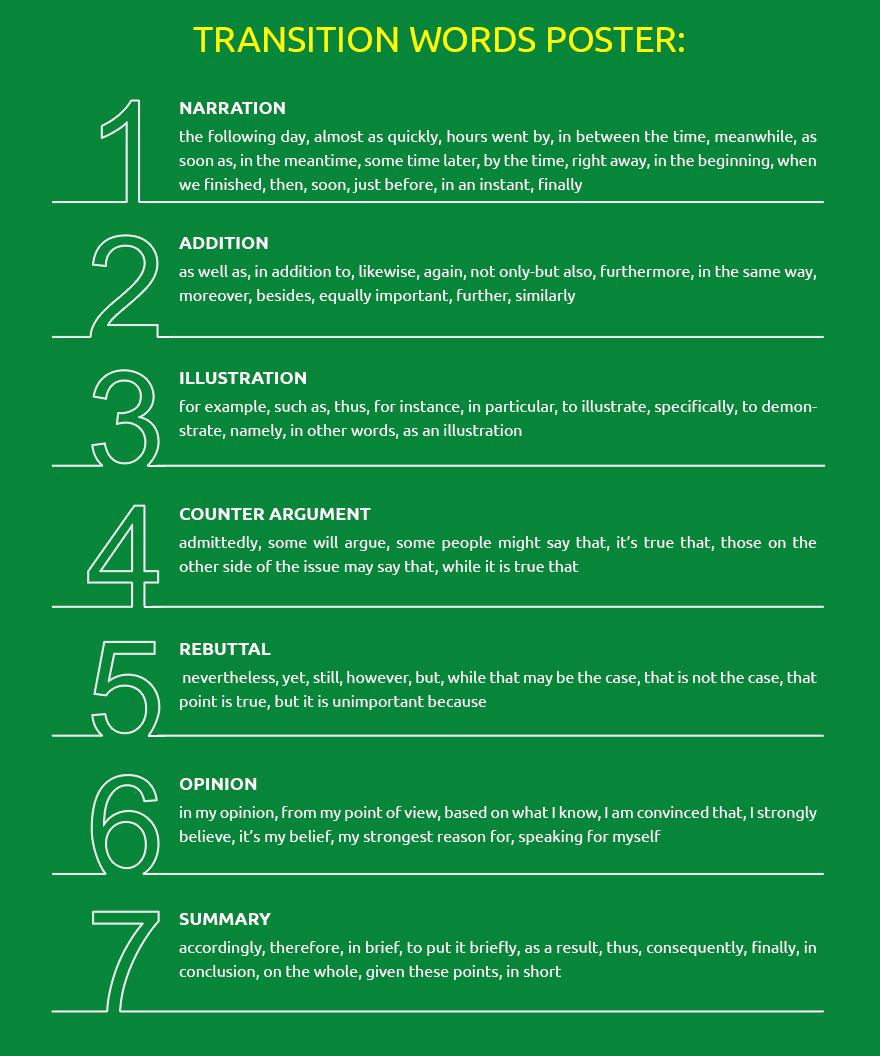4 Tips to Put Your Essay Ideas Together


Writing as a creative process requires a writer to put a great deal of energy into work. Naturally, self-efficacy can decrease over time, which leads to a period of creative stagnation. That is why both a professional writer and an inexperienced student should know how to get their game together.
Every writer encounters the same obstacles when working on an essay. To ensure you overcome all hurdles, you should answer these four questions before you start writing:
- How to begin an essay?
- How to create a thesis statement?
- How to do an outline for an essay?
- How to choose appropriate transitions?
If you feel you don’t have the definitive answers, read on to get them.
Writing an Essay: Where to Begin
Having received their first written assignment, students immediately wonder how to start a college essay. If this is your case, set out to learn how to write an introduction for an essay.
How to Start an Essay
A good essay should begin with an introduction. A proper intro opens with a hook that grabs readers’ attention. The following sentences should lead to the thesis statement that concludes the opening paragraph.
If you were to ask “how long should an introduction be?”, the answer would be very simple. The length of the introductory paragraph depends on the length of your essay. So, how long should an essay be? Unless there are no exact instructions from your professor, it is totally up to you.
An average 5-paragraph essay can take up one or two pages. In such case, the introduction varies from approximately 100 to 200 words. However, a longer essay will require a suitably longer introduction.
How to Write Good Hook Sentences
Getting the audience interested in reading your piece of writing is one of the key objectives of a successful introduction. Here are some constructive ideas of how to write a hook for an essay:
- Use staggering information: To startle the reader into reading your essay, you can provide a relevant fact that highlights the idea of the paper. For example:
Scientists claim that the risk of food insecurity is expected to increase by 20% within 30 years due to climate change. - Open with an anecdote: It is crucial to ensure the anecdote is short and to the point. It has to be pertinent to the topic of your essay and showcase your purpose: “Global warming isn’t real because I was cold today! Also great news: world hunger is over because I just ate.” Steven Colbert
- Cite a famous quote: When you decide to use a quote in the introduction, make sure it reflects the essence of your essay: Barack Obama once said, “Ask a Republican about climate change, and he’ll say he’ll say ‘I’m not a scientist!’ but when it comes to a woman’s right to choose, suddenly they all become doctors!”
- Summarize your main idea: It is also a good strategy to start with explaining the core idea of the essay from the very beginning so that it is clear what it is about: Regardless of numerous facts and substantial evidence, many of us either deny or ignore the imminent danger of climate change.
- Present a dialogue: When incorporating a dialogue in the introduction, remember to keep it short and relevant to the topic of your essay: ‘Do you believe in global warning?’ ‘Sure.’ ‘What is the main reason for it?’ ‘Bad politics?’
- Ask a question: You can also start a paragraph with a regular or rhetorical question addressed to the audience: Do you care how long our planet is going to be inhabitable?
Words to Start a Paragraph
To decide how to begin a paragraph, you should rely on the general idea of this paragraph. For this reason, essay starters described above can be used not only in the introduction but also in the body and conclusion. Furthermore, you can begin a new paragraph with a transition word or phrase if it helps to connect this paragraph to the previous one.
Example of starters for body paragraphs:
Despite the discussed criticisms, …
The above interpretation of …
By the same token, …
It can be concluded from the above analysis that, …
An equally critical point of …
An opposing explanation of this issue is that, …
This approach is similar to the …
You can try starting an essay with a quote but remember to ensure it is topical and relevant. If you choose to refer to a quotation later in the paper, start a paragraph with an appropriate reference:
The idea expressed in the quotation reflects the view that, …
There are more ways to start a paragraph here.
What is a Thesis Statement and Why is It Important
A thesis sentence is the most vital part of the introduction because it defines the direction and purpose of your essay. Whether your introduction attracts the reader or not depends greatly on how effective its final sentences are.
Let us answer the frequently asked questions about thesis:
1) What is the purpose of a thesis statement?
The thesis aims at conveying the idea of the essay and explaining its significance to the reader. It is designed to present the main argument of the essay in a clear and convincing manner.
2) Can a thesis statement be more than one sentence?
Yes, but not more than two sentences. The first sentence can be a meaningful lead to the last one that sets the goal of the essay.
3) Can a thesis statement be a question?
No, you need an affirmative sentence to express your argument.
4) What is a working thesis statement?
It is the initial version of the main idea of your paper. A working thesis statement is usually a rather broad explanation of the topic of your essay, which soon will be shortened to one or two sentences of a solid argument.
5) What are the constituent parts of a thesis statement?
An effective thesis statement should have:
- A concise definition of the topic
- A clear assertion or opinion
- Substantial evidence to support your claim
Having put all three parts together, you will get a thesis statement that claims to argue the explained case.
6) What is the difference: thesis statement vs topic sentence?
Unlike a thesis statement, a topic sentence is located at the beginning of the paragraph. It is meant to introduce the subject of the paragraph, which is investigated with the help of supporting details further in the paragraph.
7) What is an analytical thesis statement?
This type of a thesis statement demonstrates the writer’s intention to analyze a specific matter and provide sufficient evidence to prove its accuracy.
8) What is a compare and contrast thesis statement?
This type of a thesis statement is used to present differences and/or similarities that are going to be discussed in the essay. To construct such thesis, you should firstly decide which things you will compare and which things you will contrast. Then, combine both statements in one sentence to make an argument.
Thesis Statement Formula
As you can see, writing a thesis statement requires some real work. So it is best to create a working thesis statement before you make your outline so that you can modify it as many times as you need while writing the essay.
To help you get started, try using this formula to create a proper thesis statement:
Make an argument
+
Provide the basics of your evidence
+
Use effective wording
How to Outline an Essay
Having written a working thesis statement, you need to move on to another stage of an essay-writing process, i.e. writing an essay outline. So what is an essay outline? It is a road map to your essay that makes it easier to organize your thoughts and arrange them in a logical consecutive order.
A formal outline normally includes a thesis statement, topic sentences, and supporting details. However, this standard outline format can be slightly changed if needed. Since there are two major types of outlines, you can adjust the initial one to make it eventually either a sentence or topic outline.
According to outlining definition, you need to sketch the main features of your essay to ensure that the most significant aspects of your argument are included in the final draft. You can also make an outline of a separate part of the essay. For instance, a conclusion paragraph outline can be designed to help you compose a successful concluding paragraph.
How to Use Transition Words
For the audience to be able to follow your story with ease, it is necessary to include transition words in the sentences. They make the narrative flow smoothly and help better understand the content and your original intention.
Since there is plenty of various narrative transition words, you need to use the appropriate ones to complement a paragraph such as moments later, as soon as, immediately, in the meantime, initially, the next day, almost as quickly, and many other.
To strengthen your argument in a debate, you would choose to resort to counter argument transition words and phrases like admittedly, while it is true that, some will argue, and those on the other side of the issue may say that. However, to refute someone else’s reasoning, you will have to use proper rebuttal transition words and phrases such as nevertheless, yet, still, conversely, that is not the case, and that point is true, but it is unimportant because.
When using transition words for argumentative essays, be sure to provide a variety of them to make the essay more coherent and perspicuous. For this, use illustration transitions when giving examples, addition transitions when complementing a piece of information, and summary transitions when concluding and summarizing.
Similarly, if you decide to start a sentence with an opinion or quote, make sure to use adequate opinion transition words such as according to, as stated by, in the opinion of and the like.
If you want to find a proper linking word or phrase, there’s no need typing “transition words powerpoint” or “transition words list” in a search box. All you need to do is to look through our transition words poster below and get what you need.
